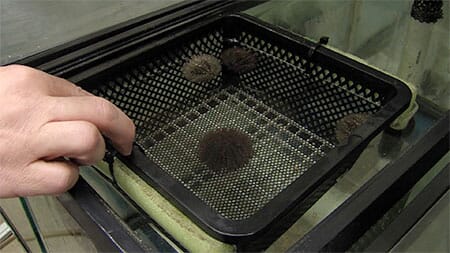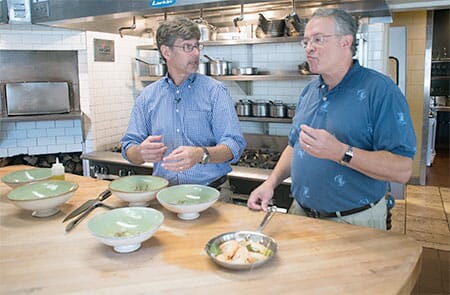Using sea urchins and shrimp as models, UAB scientists discovered that one species could feed another from its waste, without needing to use traditional food at all.
Steve Watts, Ph.D., known for the sea urchin food of his own invention that led him to be featured on The Travel Channel’s Bizarre Foods America with host Andrew Zimmern, is leading the work.
Watts and his team from the College of Arts and Sciences’ Department of Biology began this research after years of studying traditional aquatic animal research and combining it with cutting-edge science and medicine.
“Over the years, we’ve found that a number of the animals we’ve worked with are excellent models for studying aspects of medicine,” Watts said.
“Many of them are great biomedical examples, and we can study a variety of diseases and issues related to human health, so our research is really twofold. We study the animals for aquaculture and biomedical research.”
In his previous work with sea urchins, Watts began to understand that the animals could potentially support another species, sparking his interest in further pursuing that possibility.
“In some cases, we had our shrimp together with our sea urchins, and they did very well, and we noticed that the shrimp had a tendency to congregate by the sea urchins and consume the waste pellets from the urchins,” Watts said. “It looked like there might be some kind of synergy there.”

In Watts’ lab, researchers grow sea urchins and put them into a polyculture system, in which one animal supports the other. In this instance, the sea urchins support the shrimp through dropping their waste pellets through to the shrimp that live beneath the urchins, allowing them to consume the pellets and grow without the need for traditional food.
The sea urchin pellets are full of nutrients and healthy bacteria and, according to Watts’ research, help shrimp grow faster and larger than they did when consuming shrimp feed alone.
This finding has the potential to bear positive impacts in several fields.
“Fundamentally, it’s a breakthrough in polyculture science; but the positive effects could also be seen in industries that raise aquatic species and by those that buy them for restaurants,” Watts said. “Cost savings seen from reducing or eliminating the need for traditional food could be substantial.”
Farm-raised shrimp are an important part of aquaculture and to the restaurant industry. Worldwide, much of the shrimp that is cultivated for culinary interests is done so in ponds, rather than out in the ocean. In order to raise these shrimp to be harvested for market, farmers must usually buy expensive feed.
Watts’ system eliminates that cost factor.
“When you have urchins present, you won’t need the shrimp feed,” Watts said. “What we’ve found is that the shrimp do very well when just consuming the urchin pellets alone — they grow large fast and stay healthy. In many cases, they exceeded the growth rate of shrimp fed the expensive feed.”
Furthermore, chefs like Birmingham’s Chris Hastings, chef and owner of world-renowned Hot and Hot Fish Club and the newly opened Ovenbird, could stand to gain from this new system.
Watts and his research team brought their shrimp to Hastings’ Hot and Hot Fish Club for a taste test.
“If you did a side-by-side with any shrimp grown in a pond in the world that’s not done sustainably in a closed loop with organic food as its source in a clean environment, and you taste it next to this shrimp — the flavor, the texture, everything about your shrimp is world-class compared to that,” Hastings said.

“And do you know what it means for me as a chef? It means I know I have a hope and a chance of achieving what I dream in cooking,” Hastings said. “You can’t achieve those dreams with less than a perfect product.”
Watts and his team echo Hastings’ desire to create an environmentally sustainable system for the culture of many species.
“With the number of individuals in this world increasing, and the need for protein, aquaculture is going to be the only mechanism by which we are going to be able to enhance fish protein production,” Watts said. “It’s all we have.”
“Aquaculture gives us a new way of bringing in protein that we haven’t fully utilized yet,” said Karen Jensen, a master’s student in Watts’ lab. “These animals use a lot less energy than, say, a cow or a chicken to raise to full adult, and they still give us great nutrition.”
With this system’s many benefits in mind, Watts and his team will continue research on this polyculture relationship and others, aiming to bring more aquaculture to market.




